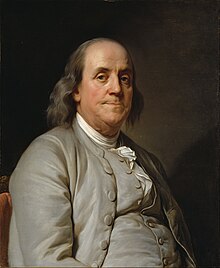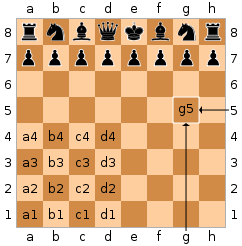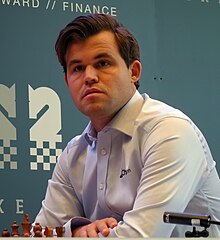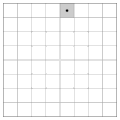
Back بوابة:شطرنج Arabic Портал:Шахмат Bulgarian প্রবেশদ্বার:দাবা Bengali/Bangla Portal:Šah BS دەروازە:شەتڕەنج CKB Portál:Šachy Czech Portal:Skak Danish Portal:Schach German Portal:Ajedrez Spanish Portail:Échecs French
Introduction
Chess is a board game for two players. It is sometimes called international chess or Western chess to distinguish it from related games such as xiangqi (Chinese chess) and shogi (Japanese chess).
Chess is an abstract strategy game that involves no hidden information and no elements of chance. It is played on a chessboard with 64 squares arranged in an 8×8 grid. The players, referred to as "White" and "Black", each control sixteen pieces: one king, one queen, two rooks, two bishops, two knights, and eight pawns. White moves first, followed by Black. The game is won by checkmating the opponent's king, i.e. threatening it with inescapable capture. There are several ways a game can end in a draw.
The recorded history of chess goes back at least to the emergence of a similar game, chaturanga, in seventh-century India. The rules of chess as they are known today emerged in Europe at the end of the 15th century, with standardization and universal acceptance by the end of the 19th century. Today, chess is one of the world's most popular games and is played by millions of people worldwide. (Full article...)
Selected article -
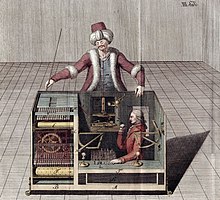
The Mechanical Turk, also known as the Automaton Chess Player (German: Schachtürke, lit. 'chess Turk'; Hungarian: A Török), or simply The Turk, was a fraudulent chess-playing machine constructed in 1770, which appeared to be able to play a strong game of chess against a human opponent. For 84 years, it was exhibited on tours by various owners as an automaton. The machine survived and continued giving occasional exhibitions until 1854, when a fire swept through the museum where it was kept, destroying the machine. Afterwards, articles were published by a son of the machine's owner revealing its secrets to the public: that it was an elaborate hoax, suspected by some, but never proven in public while it still existed.
Constructed and unveiled in 1770 by Wolfgang von Kempelen (1734–1804) to impress Empress Maria Theresa of Austria, the mechanism appeared to be able to play a strong game of chess against a human opponent, as well as perform the knight's tour, a puzzle that requires the player to move a knight to occupy every square of a chessboard exactly once. (Full article...)General images
Selected image
FIDE world ranking
| Rank | Player | Rating |
|---|---|---|
| 1 | 2832 | |
| 2 | 2802 | |
| 3 | 2796 | |
| 4 | 2778 | |
| 5 | 2770 | |
| 6 | 2769 | |
| 7 | 2763 | |
| 8 | 2757 | |
| 9 | 2757 | |
| 10 | 2755 | |
| 11 | 2751 | |
| 12 | 2748 | |
| 13 | 2745 | |
| 14 | 2745 | |
| 15 | 2744 | |
| 16 | 2733 | |
| 17 | 2731 | |
| 18 | 2729 | |
| 19 | 2726 | |
| 20 | 2725 |
Top 10 WikiProject Chess Popular articles of the month
Did you know...
- ... that Magnus Carlsen, the current World Chess Champion, resigned a recent tournament game after only one move?
Reviewed articles
Chess from A to Z
| Index: | A B C D E F G H I J K L M N O P Q R S T U V W X Y Z (0–9) |
| Glossary: | A B C D E F G H I J K L M N O P Q R S T U V W X Y Z |
Topics
Subcategories
Related portals
Related WikiProjects
Associated Wikimedia
The following Wikimedia Foundation sister projects provide more on this subject:
-
Commons
Free media repository -
Wikibooks
Free textbooks and manuals -
Wikidata
Free knowledge base -
Wikinews
Free-content news -
Wikiquote
Collection of quotations -
Wikisource
Free-content library -
Wikiversity
Free learning tools -
Wiktionary
Dictionary and thesaurus
Sources
© MMXXIII Rich X Search. We shall prevail. All rights reserved. Rich X Search
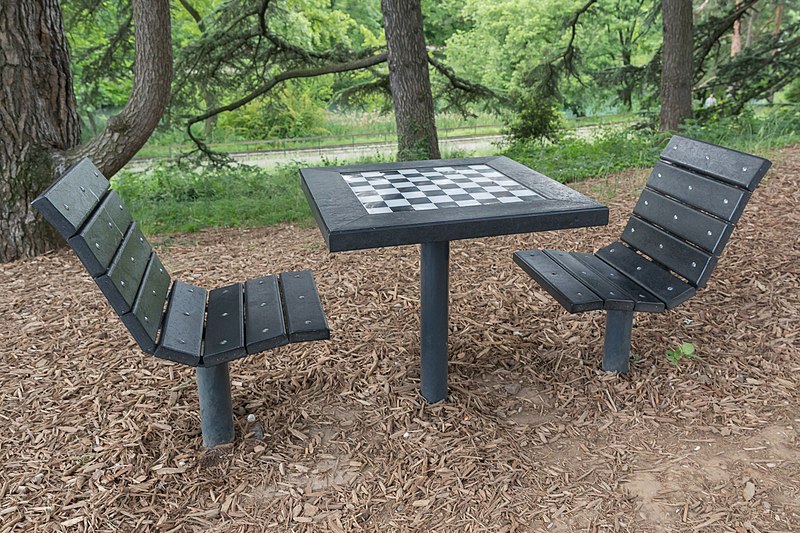
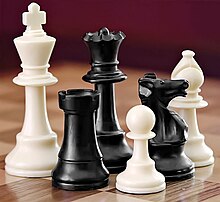









































![Image 1 Portrait by Joseph Duplessis, 1778 Benjamin Franklin FRS FRSA FRSE (January 17, 1706 [O.S. January 6, 1705] – April 17, 1790) was an American polymath: a leading writer, scientist, inventor, statesman, diplomat, printer, publisher, and political philosopher. Among the most influential intellectuals of his time, Franklin was one of the Founding Fathers of the United States; a drafter and signer of the Declaration of Independence; and the first postmaster general. (Full article...)](http://upload.wikimedia.org/wikipedia/en/d/d2/Blank.png)
